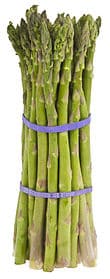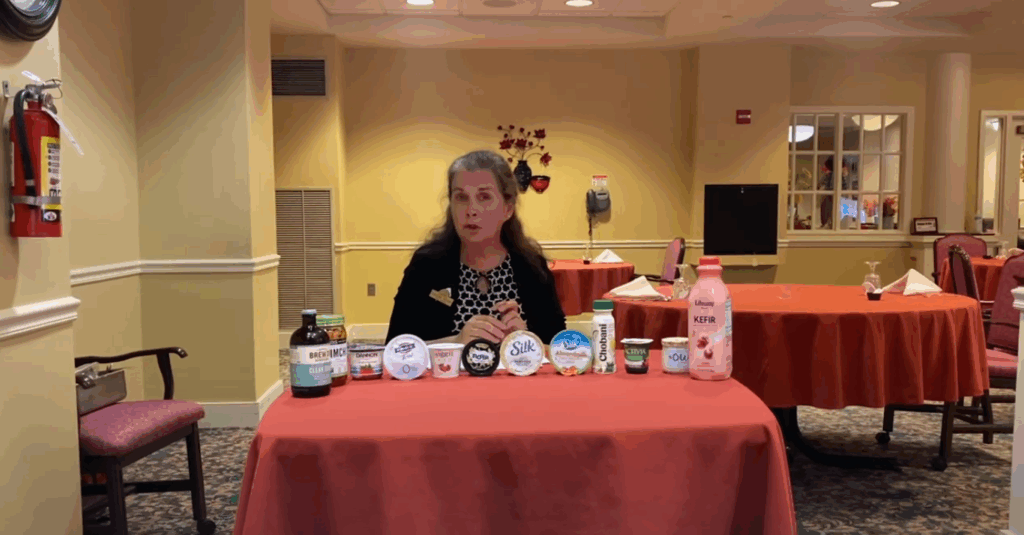What’s Cooking? Pre and Probiotics
Our Dietician Carol Valle discusses pre and probiotics including what they are, how to include them in your diet and their health benefits. Watch the video or read the transcription below.
Hi, everybody. Today’s topic is going to be probiotics and prebiotics. At the end of our talk we’re going to take a look at some of the different probiotics and prebiotics types of foods you can include in your diet.
You Are What You Eat
I want to start by saying, you are what you eat; not just the foods and fluids I show in the video, but the tiny little organisms you ingest every day that you don’t even know about and live in your gastrointestinal tract. These organisms play a very key role in bowel function and your immune function. The lining of your gut is full of microscopic organisms, mostly bacteria. There are over a thousand different species of bacteria that live in your body. Although very tiny, they play an oversized role in your health.
In the discussion about pre and probiotics we’re going to discuss what they are, how to include them in your diet – which you are probably are already doing, and the health benefits you can gain from them. We’ll then take a closer look at some of the foods that are considered very good source of probiotics, yogurt being a perfect example.
Maintain the Balance!
There are two ways to maintain the balance of healthy bacteria in your body. You can help the microbes that are already present in your gut grow by providing them with foods that contain prebiotics and you can add living microbes to your system through probiotics.
Prebiotics
Prebiotics are the non-digestible food ingredients that stimulate the growth of bacteria in your gut. They act like a fertilizer to what is already present in your healthy gut. When you eat foods that are high in prebiotics, they are providing nutrients to help those good bacteria continue to grow, thrive and do what they need to do. Prebiotics are found in foods that contain complex carbohydrates. Think fiber. High fiber foods are a complex carbohydrate. These carbohydrates are not digestible to your body. They basically pass through your digestive system and become food for the bacteria and the other microbes that are living in your gut.
Where to Find Prebiotics

Good news! Prebiotics are found in many fruits and vegetables. Having a variety of food in your diet provides your body with a constant source of prebiotics. You don’t have to go out and buy a special prebiotic supplement, just look for these foods:
- Asparagus
- Bananas
- Garlic
- Onions
- Leeks
- Beans
- Barley
- Oats
- Artichokes
- Chicory
- Dandelion greens
The bottom line is if you eat a well-balanced diet and include complex carbohydrates in your diet, you will have plenty of nutrients via the prebiotics to feed your healthy gut.
Prebiotic Supplements
You can take an over the counter prebiotic supplement, but it’s really not necessary unless it’s recommended by your physician.
Probiotics
Everybody’s talking about probiotics. Probiotics are live, beneficial bacteria – the keyword is live – that help boost your immunity and help regulate GI function and GI health. If you have ever been prescribed antibiotics, your physician may have also prescribed a probiotic to take at the same time to help maintain your gut health. When taken orally, these probiotics benefit you by improving the intestinal microbial balance of all the microorganisms in your body.
I did find a piece of research that showed as we age the beneficial bacteria in our body declines. In children, Bifidobacterium bacteria, which is very common, comprises 95% of the microbial population. As you age that amount falls to about 25%. Your microbial population kind of drains as you get older. Anything you can do to add back to that microbial population is to your benefit.
There are different microbes that are found throughout different parts of your GI, which follows a path from your mouth, esophagus, stomach, small and large intestines to your colon.
There are good bacteria like the lactobacillus bacteria, which is what you find in most of yogurts. They help your body fight the harmful effects of the bad bacteria, which include:
- E.coli
- Salmonella
- Clostridium (which causes C. diff)
If your body ingests one of those bad bacteria, the good bacteria from the probiotics help fight that infection. The good bacteria helps your immune system and maintain balance and good gut health.
I have personally seen positive effects from the use of probiotics from our Health Care Center residents who have had a C. diff infection, which may have occurred from long-term antibiotic use or an extended hospitalization. Giving them a probiotic, in addition to the antibiotic they’re taking, has sped up their recovery.
Live Organisms
Probiotics are live organisms. You can obtain them from either food or supplements. A probiotic supplement is something you can buy over the counter. You want to look for one that has guaranteed live cells at the time of purchase, not at the time of manufacture. There are probiotics on the market that are being sold that have no strength to them because the probiotics were killed during the manufacturing process. Look on the side of the box to be sure that it has live cells at the time of purchase.
One well known example is Culturelle; it’s an over-the-counter probiotic. It’s been widely studied; it contains active live cells, and it’s very easy to find in stores.
There are a lot of brands available, but do your research. A lot are a waste of your money not only because the bacteria isn’t live, but you really don’t need to purchase a probiotic supplement because you can get them from your diet.
Getting Probiotics from Your Diet
Adding probiotics to your diet is very easy, and available from foods you enjoy. Foods that are high in probiotics include those that have been fermented. Fermented dairy foods include things like yogurt, kefir and even some of your aged cheeses.
Fermented non-dairy foods could be something like kimchi, which is a Korean vegetable dish. Kombucha is a fermented tea. There’s even ferment soy and almond milk, providing us with soy and almond yogurts.
Yogurt

Yogurt is a food that goes back to ancient times. It can be found in every country in the world. When I was doing my research, I surprised by how it’s been made. Yogurt is typically made from cow’s milk that’s been fermented by adding bacteria to the milk, which produces lactic acid. Some countries use cultured milk that is thickened through the addition of bacteria. The bacteria produces lactic acid, which creates the sour flavor and thickens it. The bacteria that is left in the yogurt after the fermenting process is the final product that you’re going to eat, thus adding probiotics to your diet. It’s an excellent source of probiotics, as well as protein and calcium. It can be fat free, or it can be relatively high in fat. It depends on the type of milk or the base that’s used.
Popular yogurts made from cow’s milk include:
- Fage
- Dannon
- Chobani
- Activia
- French Yogurts, like Oui
You can also find yogurts made from goat, sheep, coconut and soy milk.
You can use yogurt in recipes. It’s a great snack food and it’s a typical breakfast food. If you get your children started on yogurt early, they tend to be lifelong yogurt eaters.
What to Look for and Avoid?
Like probiotic supplements, the truth lies in the yogurt’s label. There are only two ingredients that are needed to make yogurt – milk and live and active cultures. Anything else is an additive.
Look for a yogurt that doesn’t have a list of added ingredients a mile long. You’re looking for milk and cultures. Everything else is an additive. You want to avoid yogurts that are high in water, sugar, fructose, corn starch and artificial sweeteners such as sucralose. Some of the yogurts out there are fat free and sugar-free, but when you taste them, you have this aftertaste that comes from the artificial sweetener in many of the low-fat, low-calorie yogurts. Sometimes it’s better to get a plain yogurt and add your own sweetener to it, maybe a drop of honey, a little bit of fruit, some crunchy granola, something to spice it up. But don’t let the manufacturer do that for you.
Avoid “whey concentrate,” an additive that’s added to boost the protein, but it’s not the protein that’s coming from the milk. It’s just an additive. “Modified corn starch” is just a thickener. True high-quality yogurts are thick on their own accord. This is another additive.
Stay away from the fruited yogurts. I only say this because when I started eating yogurt, my go-to yogurt had fruit on the bottom like some Dannon yogurts. When you look at the label, the amount of sugar, 21 grams, far outweighs the amount of protein, five grams. It would be bet much better to get a plain Dannon yogurt and add your own sweetener or fruit, because fruited yogurts are is pretty much pureed fruit with sugar in it on the bottom.
Dannon is a nice way to start kids getting used to the taste of yogurt. It is a traditional unstrained yogurt, so it’s thinner than the Greek yogurts. It has more liquid, and many times there’s fruit on the bottom. There’s nothing wrong with it. You just don’t have as much nutritional benefit from this yogurt as you do from some of the others, but it does have live and active cultures, so it does have probiotics in it.

Other Sources of Probiotics
- Sauerkraut is a cabbage that has been fermented with lactic acid bacteria. Sauerkraut is a very good source of probiotics.
- Kimchi is a spicy fermented vegetable. You often see this in Korean or Asian markets. Like sauerkraut, the main ingredient is cabbage. I don’t know if you could tell by the color of it but it also contains chili flakes, garlic, ginger and onions. If you like something a little bit spicy, kimchi might be a good option for adding probiotics to your diet. Though you might want to use it sparingly until you get used to the taste and if you’re watching your salt intake. Kimchi is high in salt.
- Tempeh is a fermented soybean paste that’s used as a high protein meat supplement.
- Miso is made from fermented soybeans and a kind of Japanese seasoning. It’s the basis for miso soup.
- Kefir is a Japanese fermented milk drink. We use kefir quite a bit in the Health Care Center. We give residents servings of this when they’re onantibiotics to provide them with additional probiotics. It’s a little bit tart but most kefir drinks are flavored. It’s very easy to find in your local grocery store.


cultured buttermilk and the process of culturing the buttermilk or pasteurizing the buttermilk kills the probiotics. To get true traditional buttermilk, you would have to go to places like India or Pakistan.







